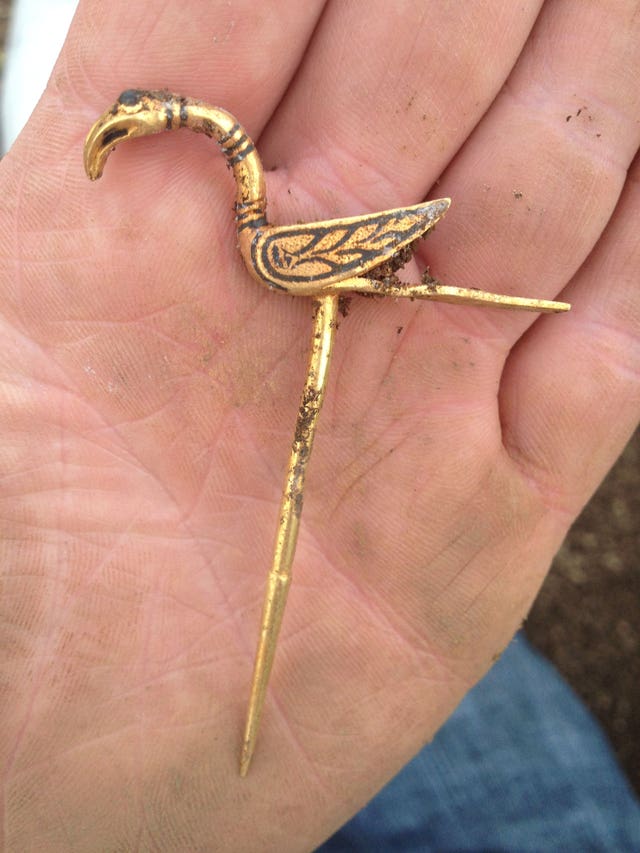
Research into a £2 million Viking-age hoard found in a field has uncovered the name of one of its original owners on a silver arm ring.
An expert examining Anglo-Saxon runic inscriptions on arm rings in the hoard found the name “Ecgbeorht”, which would be Egbert in its modern form.
The discovery suggests the treasure, known as the Galloway Hoard, may have been left by people who considered themselves part of the English-speaking world rather than Scandinavians.
READ MORE: Viking-era hoard to roam Scotland again: Galloway Hoard to go on tour of country
Metal detectorist Derek McLennan uncovered the 10th-century treasure trove, which includes silver bracelets and brooches, a gold ring, an enamelled Christian cross and a bird-shaped gold pin, in a field in Dumfries and Galloway in 2014.
 The Galloway Hoard includes more than 100 items (National Museums Scotland/PA)
The Galloway Hoard includes more than 100 items (National Museums Scotland/PA)
National Museums Scotland raised £1.98 million to acquire the array of more than 100 items for the nation and it is currently being conserved and researched at the National Museums Collection Centre in Edinburgh.
Dr David Parsons of the University of Wales examined the runes which are found on five of the silver arm rings.
READ MORE: Lewis Chessman bought for £5 is sold for more than £700,000 at Sotheby’s auction
He said: “Arm rings of this sort are most commonly associated with Viking discoveries around the Irish Sea coastlands.
“Yet these runes are not of the familiar Scandinavian variety common around this date on the nearby Isle of Man, but of a distinctively Anglo-Saxon type.
“While several of the texts are abbreviated and uncertain, one is splendidly clear: it reads Ecgbeorht, Egbert, a common and thoroughly Anglo-Saxon man’s name.

Could “Ecgbeorht” have been the piece's owner?
He added: “There is some reason, therefore, to suspect that the Galloway ‘Viking’ Hoard may have been deposited by a people who, to judge by name and choice of script, may have considered themselves part of the English-speaking world.
“It is even possible that these were locals: Galloway had been part of Anglo-Saxon Northumbria since the early eighth century, and was referred to as the ‘Saxon coast’ in the Irish chronicles as late as the 10th century.”
As well as the arm ring with the full name of Egbert, four others have runic inscriptions.
Three appear to be abbreviated names, probably also Old English, whilst the fifth has still to be deciphered, but all are in Anglo-Saxon runes.
 The hoard includes a bird pin (Dumfries and Galloway Council/PA)
The hoard includes a bird pin (Dumfries and Galloway Council/PA)
It is thought the arm rings may have functioned as labels identifying distinct portions of the hoard, perhaps recording the names of the people who owned and buried them.
Dr Adrian Maldonado, Glenmorangie Research Fellow at National Museums Scotland, said: “It’s really exciting to be able to reveal the first major research finding from the conservation of the Galloway Hoard, a message left by one of the individuals who deposited the hoard 1,100 years ago.
READ MORE: Future of Viking hoard should be discussed at summit, says Culture Secretary
“We don’t know any more about Egbert than his name right now but there’s something really tantalising about connecting the Galloway Hoard with a named person.
“Egbert is a common Anglo-Saxon name, and with more research on the rest of the contents of the hoard we will be able to narrow down its dating and suggest some candidates from the historical record.
“If the hoard belonged to a person or group of Anglo-Saxon speakers, does it mean they were out raiding with other Vikings? Or that these Viking hoards were not always the product of Scandinavian raiders?
“There are other explanations, but either way this transforms our thinking on the ‘Viking Age’ in Scotland.”
An exhibition of the Galloway Hoard will be displayed at the National Museum of Scotland in May, and will then tour until 2022 visiting Kirkcudbright Galleries, The McManus: Dundee’s Art Gallery and Museum, and Aberdeen Art Gallery.



Why are you making commenting on The Herald only available to subscribers?
It should have been a safe space for informed debate, somewhere for readers to discuss issues around the biggest stories of the day, but all too often the below the line comments on most websites have become bogged down by off-topic discussions and abuse.
heraldscotland.com is tackling this problem by allowing only subscribers to comment.
We are doing this to improve the experience for our loyal readers and we believe it will reduce the ability of trolls and troublemakers, who occasionally find their way onto our site, to abuse our journalists and readers. We also hope it will help the comments section fulfil its promise as a part of Scotland's conversation with itself.
We are lucky at The Herald. We are read by an informed, educated readership who can add their knowledge and insights to our stories.
That is invaluable.
We are making the subscriber-only change to support our valued readers, who tell us they don't want the site cluttered up with irrelevant comments, untruths and abuse.
In the past, the journalist’s job was to collect and distribute information to the audience. Technology means that readers can shape a discussion. We look forward to hearing from you on heraldscotland.com
Comments & Moderation
Readers’ comments: You are personally liable for the content of any comments you upload to this website, so please act responsibly. We do not pre-moderate or monitor readers’ comments appearing on our websites, but we do post-moderate in response to complaints we receive or otherwise when a potential problem comes to our attention. You can make a complaint by using the ‘report this post’ link . We may then apply our discretion under the user terms to amend or delete comments.
Post moderation is undertaken full-time 9am-6pm on weekdays, and on a part-time basis outwith those hours.
Read the rules here